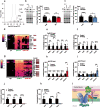Speg interactions that regulate the stability of excitation-contraction coupling protein complexes in triads and dyads
- PMID: 37709832
- PMCID: PMC10502019
- DOI: 10.1038/s42003-023-05330-y
Speg interactions that regulate the stability of excitation-contraction coupling protein complexes in triads and dyads
Abstract
Here we show that striated muscle preferentially expressed protein kinase α (Spegα) maintains cardiac function in hearts with Spegβ deficiency. Speg is required for stability of excitation-contraction coupling (ECC) complexes and interacts with esterase D (Esd), Cardiomyopathy-Associated Protein 5 (Cmya5), and Fibronectin Type III and SPRY Domain Containing 2 (Fsd2) in cardiac and skeletal muscle. Mice with a sequence encoding a V5/HA tag inserted into the first exon of the Speg gene (HA-Speg mice) display a >90% decrease in Spegβ but Spegα is expressed at ~50% of normal levels. Mice deficient in both Spegα and Speg β (Speg KO mice) develop a severe dilated cardiomyopathy and muscle weakness and atrophy, but HA-Speg mice display mild muscle weakness with no cardiac involvement. Spegα in HA-Speg mice suppresses Ca2+ leak, proteolytic cleavage of Jph2, and disruption of transverse tubules. Despite it's low levels, HA-Spegβ immunoprecipitation identified Esd, Cmya5 and Fsd2 as Spegβ binding partners that localize to triads and dyads to stabilize ECC complexes. This study suggests that Spegα and Spegβ display functional redundancy, identifies Esd, Cmya5 and Fsd2 as components of both cardiac dyads and skeletal muscle triads and lays the groundwork for the identification of new therapeutic targets for centronuclear myopathy.
© 2023. Springer Nature Limited.
Conflict of interest statement
The authors declare the following competing interests: X.H.T.W. is a founding partner and board member of Elex Biotech, a start-up company that developed drug molecules to target ryanodine receptors to treat cardiac arrhythmias. The remaining authors declare no competing interests.
Figures






References
Publication types
MeSH terms
Substances
Grants and funding
LinkOut - more resources
Full Text Sources
Molecular Biology Databases
Research Materials
Miscellaneous

